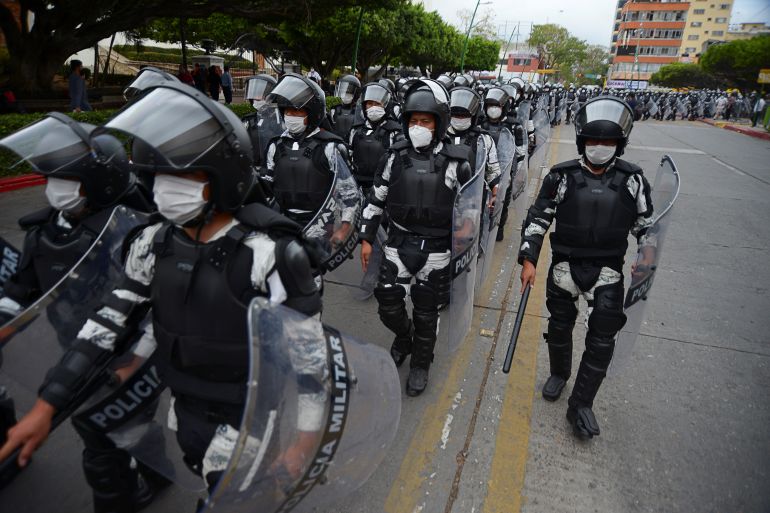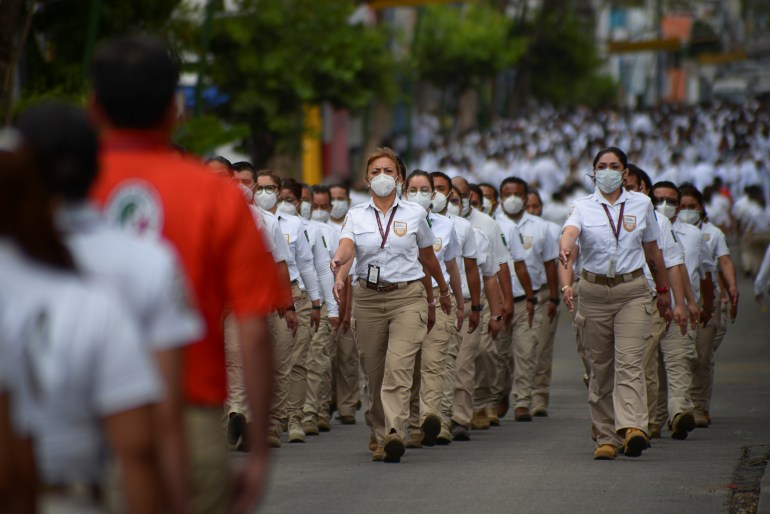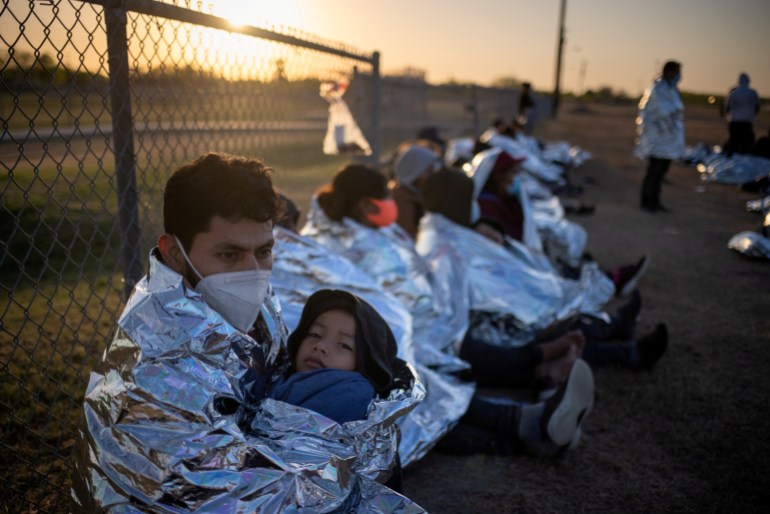Mexico dispatches troops to southern border to rein in migrants
Citing the need to stop the spread of the coronavirus, Mexico is restricting all but essential travel with Guatemala.

Mexico reinforced its southern border with Guatemala with immigration agents and national guard troops after the country announced it would limit all non-essential travel between the two countries.
Local media reported that the Suchiate River which separates Guatemala and Mexico was being lined with an enhanced security presence to contain a growing flow of immigrants heading to the United States.
Keep reading
list of 3 itemsBiden, Dems unveil sweeping immigration reform legislation
US immigration agents ordered to focus on serious criminals
Last week, the US announced that it is facing the largest surge in migrants arrivals in 20 years.
On Friday, the Mexican government announced that non-essential travel would be restricted between the two countries, and local media reported that officers from the country’s National Migration Institute began deploying on the banks of the river on Saturday. On Sunday, military troops began arriving.

The Mexican Foreign Ministry said the move was needed to prevent the further spread of COVID-19 and would remain in place until at least April 21.
Para prevenir la propagación de #COVID19, 🇲🇽 impondrá a partir del 19 de marzo de 2021, restricciones al tránsito terrestre para actividades no esenciales en su frontera norte y sur.
— Relaciones Exteriores (@SRE_mx) March 18, 2021
Translation: To prevent the spread of COVID-19, Mexico will impose as of March 19, 2021 restrictions on land traffic for non-essential activities on its northern and southern borders.
The announcement came on the same day that Mexican President Andres Manuel Lopez Obrador confirmed that the US would ship 2.7 million coronavirus vaccine shots to Mexico.
US and Mexican officials have denied that the two issues are related.
“There have been expectations set outside of, unrelated, to any vaccine doses or request for them that they would be partners in dealing with the crisis on the border,” White House Press Secretary Jen Psaki said during a regular news conference on Thursday. “Every relationship has multiple layers of conversations that are happening at the same time.”
“With every country, there’s rarely just one issue you’re discussing with any country at one time,” she said.
Roberto Velasco, director of North American affairs at the Mexican Foreign Ministry, said migration and coronavirus vaccines are separate issues, but added that the two countries will continue to cooperate on ensuring that immigration can be accessed in an “orderly, safe and regular manner”.

“These are two separate issues on a common agenda,” he wrote on Twitter. “Migration and vaccination against COVID-19 are different topics.”
US President Joe Biden, who took office in January, promised to impose more humane immigration policies than his predecessor Donald Trump. But in recent weeks, he has faced intense pressure from his Republican rivals who have accused him of signalling an “open borders” policy, encouraging migrants to flood the US-Mexico border.
Top US immigration officials are set to meet with Mexico’s foreign ministry on Tuesday, the White House announced Monday.
“Special Assistant to the President and Coordinator for the Southwest Border, Ambassador Roberta Jacobson will travel to Mexico on March 22 to engage with Mexican government officials to develop an effective and humane plan of action to manage migration,” National Security Council spokesperson Emily Horne said in a statement. “She will be joined by Special Assistant to the President and Senior Director for the Western Hemisphere Juan Gonzalez.”
Gonzalez will then travel to Guatemala to meet with officials and others there, Horne said.
On Sunday, Biden told reporters that he planned on visiting the nation’s southern border, but did not say when.
He said his administration is working to establish a system whereby migrants “can stay in place and make their case from their home countries”, rather than take the often dangerous journey towards the US-Mexico border to claim asylum.
Over the weekend, local media reported that many who were being returned to Mexico’s southern borders were not migrants, but Guatemalan residents and sellers who live across the river, who routinely cross into Mexico on small rafts to buy merchandise before going back home.